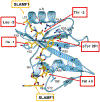SLAMF6 in health and disease: Implications for therapeutic targeting
- PMID: 30366106
- PMCID: PMC8969216
- DOI: 10.1016/j.clim.2018.10.013
SLAMF6 in health and disease: Implications for therapeutic targeting
Figures






Similar articles
-
SLAMF6 clustering is required to augment T cell activation.PLoS One. 2019 Jun 14;14(6):e0218109. doi: 10.1371/journal.pone.0218109. eCollection 2019. PLoS One. 2019. PMID: 31199820 Free PMC article.
-
Slamf6 negatively regulates autoimmunity.Clin Immunol. 2016 Dec;173:19-26. doi: 10.1016/j.clim.2016.06.009. Epub 2016 Jun 29. Clin Immunol. 2016. PMID: 27368806 Free PMC article.
-
Soluble SLAMF6 Receptor Induces Strong CD8+ T-cell Effector Function and Improves Anti-Melanoma Activity In Vivo.Cancer Immunol Res. 2018 Feb;6(2):127-138. doi: 10.1158/2326-6066.CIR-17-0383. Epub 2018 Jan 5. Cancer Immunol Res. 2018. PMID: 29305520
-
Signaling lymphocyte activation molecule family in systemic lupus erythematosus.Clin Immunol. 2019 Jul;204:57-63. doi: 10.1016/j.clim.2018.11.001. Epub 2018 Nov 8. Clin Immunol. 2019. PMID: 30415085 Review.
-
CD84 cell surface signaling molecule: An emerging biomarker and target for cancer and autoimmune disorders.Clin Immunol. 2019 Jul;204:43-49. doi: 10.1016/j.clim.2018.10.017. Epub 2018 Oct 26. Clin Immunol. 2019. PMID: 30522694 Review.
Cited by
-
Melphalan flufenamide inhibits osteoclastogenesis by suppressing proliferation of monocytes.Bone Rep. 2021 Jun 7;15:101098. doi: 10.1016/j.bonr.2021.101098. eCollection 2021 Dec. Bone Rep. 2021. PMID: 34150958 Free PMC article.
-
SLAMF6 clustering is required to augment T cell activation.PLoS One. 2019 Jun 14;14(6):e0218109. doi: 10.1371/journal.pone.0218109. eCollection 2019. PLoS One. 2019. PMID: 31199820 Free PMC article.
-
Endometrial regeneration cell-derived exosomes loaded with siSLAMF6 inhibit cardiac allograft rejection through the suppression of desialylation modification.Cell Mol Biol Lett. 2024 Oct 1;29(1):128. doi: 10.1186/s11658-024-00645-y. Cell Mol Biol Lett. 2024. PMID: 39354345 Free PMC article.
-
RT-DOb, a switch gene for the gene pair {Csf1r, Milr1}, can influence the onset of Alzheimer's disease by regulating communication between mast cell and microglia.PLoS One. 2023 Jul 6;18(7):e0288134. doi: 10.1371/journal.pone.0288134. eCollection 2023. PLoS One. 2023. PMID: 37410787 Free PMC article.
-
Changing the location of proteins on the cell surface is a promising strategy for modulating T cell functions.Immunology. 2024 Oct;173(2):248-257. doi: 10.1111/imm.13828. Epub 2024 Jul 1. Immunology. 2024. PMID: 38952142 Free PMC article. Review.
References
-
- Engel P, Eck MJ, Terhorst C, The SAP and SLAM families in immune responses and X-linked lymphoproliferative disease, Nature reviews. Immunology, 3 (2003) 813–821. - PubMed
-
- Calpe S, Wang N, Romero X, Berger SB, Lanyi A, Engel P, Terhorst C, The SLAM and SAP gene families control innate and adaptive immune responses, Advances in immunology, 97 (2008) 177–250. - PubMed
-
- Ma CS, Deenick EK, The role of SAP and SLAM family molecules in the humoral immune response, Annals of the New York Academy of Sciences, 1217 (2011) 32–44. - PubMed
-
- Wang N, Morra M, Wu C, Gullo C, Howie D, Coyle T, Engel P, Terhorst C, CD150 is a member of a family of genes that encode glycoproteins on the surface of hematopoietic cells, Immunogenetics, 53 (2001) 382–394. - PubMed
Publication types
MeSH terms
Substances
Grants and funding
LinkOut - more resources
Full Text Sources
Other Literature Sources

